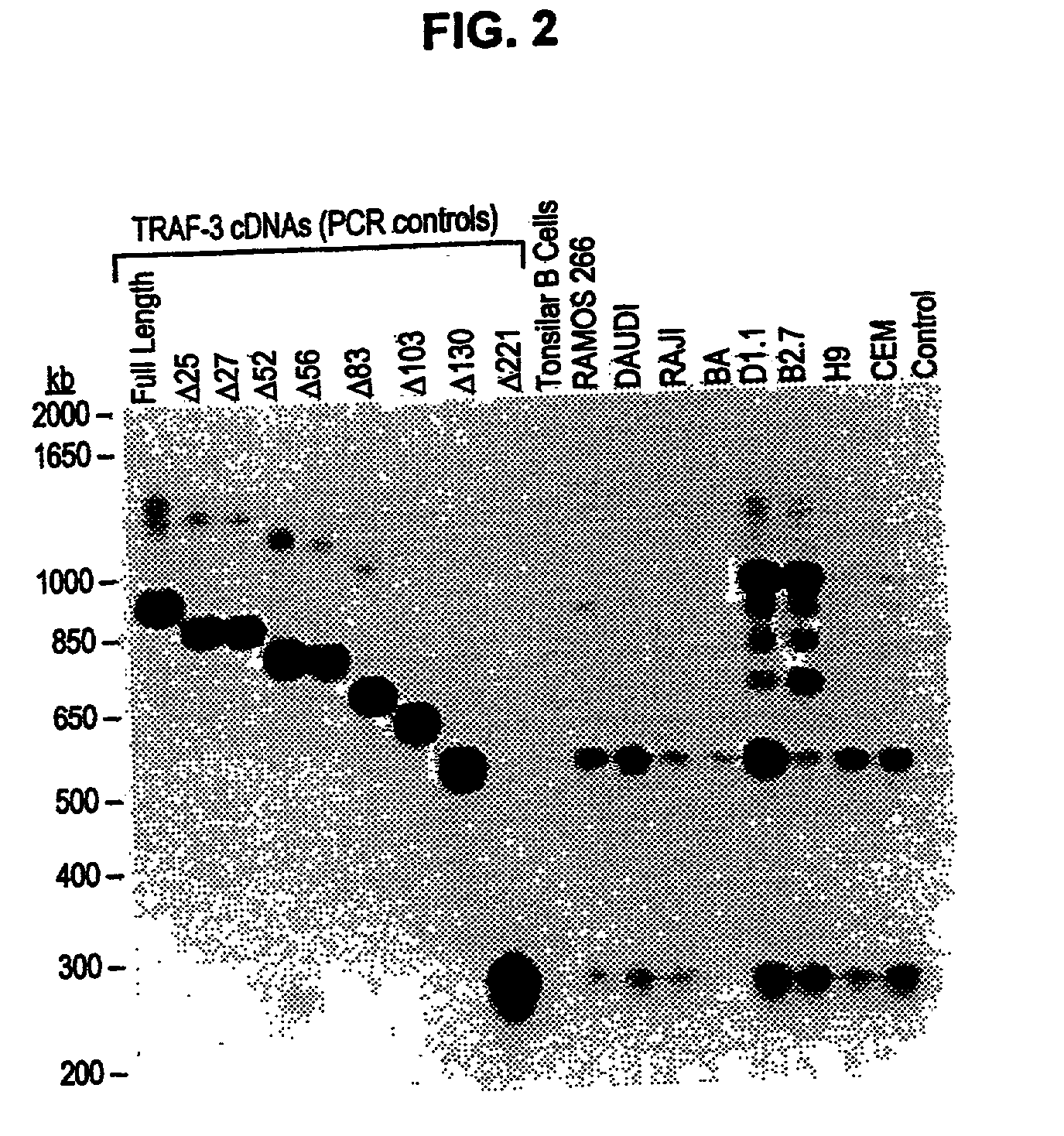TRAF-3 deletion isoforms and uses thereof
a technology of splice-deletion and isoforms, which is applied in the field oftraf3 deletion isoforms, can solve the problems of not understanding the functions of identified or predicted splice-deletion variants, and the addition of splice-deletion variants have not been characterized, so as to inhibit autoimmune responses, inhibit apoptosis, and inhibit the effect of activation of cells
- Summary
- Abstract
- Description
- Claims
- Application Information
AI Technical Summary
Benefits of technology
Problems solved by technology
Method used
Image
Examples
example 3
Gene Therapy
[0210] The invention features expression vectors for in vivo transfection and expression in particular cell types of TRAF-3 deletion isoform mutants so as to antagonize the function of wild type TRAF-3 in an environment in which the wild-type protein is expressed (i.e., introduce abnormal TRAF-3 deletion isoform that acts as a dominant negative protein to inhibit CD40 signaling).
[0211] Expression constructs of TRAF-3 deletion isoform polypeptides may be administered in any biologically effective carrier that is capable of effectively delivering a polynucleotide sequence encoding the TRAF-3 isoform to cells in vivo. Approaches include insertion of the subject gene in viral vectors including recombinant retroviruses, baculovirus, adenovirus, adeno-associated virus and herpes simplex virus-1, or recombinant bacterial or eukaryotic plasmids. Viral vectors transfect cells directly, plasmid DNA can be delivered with the help of, for , example, cationic liposomes or derivatized...
example # 4
EXAMPLE #4
Expression and Function of TRAF-3 Splice-variant Isoforms in Human Lymphoma Cell Lines
[0221] [Abbreviations used)]: TRAF, TNF receptor-associated factor; NF-.kappa.B, Nuclear factor-KB; TNF-R, Tumor Necrosis Factor Receptor; IVT, in vitro transcription; NIK, NF-.kappa.B-inducing kinase; ASK1, Apoptosis Signaling-regulated Kinase 1; I.kappa.E, Inhibitor of NF-K.kappa.B; IKK, I.kappa.B Kinase; N-terminal, amino-terminal; C-terminal, carboxy-terminal; ORF, open reading frame; RT, reverse transcriptase; .beta.-gal, .beta.-galactosidase; His, histidine; aa, amino acid; HA-tagged, hemagglutinin epitope tagged fusion construct; His-tagged, poly-histidine fusion construct; TBST, Tris buffered saline with 0.1% Tween-20; IMDM, Iscove's Modified Dulbecco's Media.
[0222] Abstract
[0223] TRAF-3 gene products are signaling adaptor molecules required for lymphocytes to mediate T-dependent antibody responses in vivo. Previous work identified 8 splice-variant TRAF-3 mRNA species by RT-PCR th...
example 1
References for Example 1
[0264] Alt, F. W., Bothwell, A. L., Knapp, M., Siden, E., Mather, E., Koshland, M., and Baltimore, D. (1980). Synthesis of secreted and membrane-bound immunoglobulin mu heavy chains is directed by mRNAs that differ at their 3' ends. Cell 20, 293-301.
[0265] Arch, R. H. and Thompson, C. B. (1998). 4-1BB and Ox40 are members of a tumor necrosis factor (TNF)--nerve growth factor receptor subfamily that bind TNF receptor-associated factors and activate nuclear factor kappaB. Mol.Cell Biol. 18, 558-565.
[0266] Boucher, L. M., Marengere, L. E., Lu, Y., Thukral, S., and Mak, T. W. (19.97). Binding sites of cytoplasmic effectors TRAF1, 2, and 3 on CD30 and other members of the TNF receptor superfamily. Biochem.Biophys.Res.Comnmun. 233, 592-600.
[0267] Brink, R. and Lodish, H. F. (1998). Tumor necrosis factor receptor (TNRF)-associated factor 2A (TRAF2A), a TRAF2 splice variant with an extended RING finger domain that inhibits TNFR2-mediated NF-kappaB activation. Journal...
PUM
| Property | Measurement | Unit |
|---|---|---|
| temperature | aaaaa | aaaaa |
| pH | aaaaa | aaaaa |
| volume | aaaaa | aaaaa |
Abstract
Description
Claims
Application Information
 Login to View More
Login to View More - R&D
- Intellectual Property
- Life Sciences
- Materials
- Tech Scout
- Unparalleled Data Quality
- Higher Quality Content
- 60% Fewer Hallucinations
Browse by: Latest US Patents, China's latest patents, Technical Efficacy Thesaurus, Application Domain, Technology Topic, Popular Technical Reports.
© 2025 PatSnap. All rights reserved.Legal|Privacy policy|Modern Slavery Act Transparency Statement|Sitemap|About US| Contact US: help@patsnap.com



